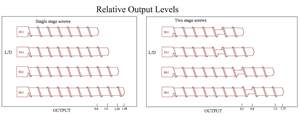DeDuster Systems Cleans Up rPET Sheet
rPlanet cut its gel count drastically—allowing it to sell more sheet at prime prices—after installing a DeDuster system.
Gels were not on rPlanet Earth’s radar when the vertically integrated rPET processor started up back in 2018. Under one roof at its 300,000+ ft2 plant in Vernon, Calif., rPlanet takes in bottles, clamshell containers, and other packaging waste from curbside collection; puts it through an extensive series of sorting and cleaning procedures; grinds it into flake and subjects it to rigorous washing and decontamination; raises the intrinsic viscosity (IV) of the material in accordance with end-use requirements; and processes it into food-grade sheet, thermoformed containers, and injection molded preforms for bottles.
But those nasty gels became an issue in rPlanet’s extruded sheet soon after the plant was started. Gels are visual defects that can be caused by a variety of factors. No one wants gels, so quality-control departments are trained to be on the lookout for them. They use industry-standard references to manually count gels, or expensive automated machines that can count them automatically. Rolls of sheet with out-of-spec gel counts are sold at a significantly discounted rate, or must be ground up for reuse, which hurts the bottom line.

Gels are a common problem often caused by dusty, contaminated materials and the defects they cause can negatively impact the price a sheet processor can demand for its product. Photos: Pelletron Corp.
While gels can be caused by several different things, dust and other fine contaminates are high on the list. Recycled bottle flake is notoriously dusty because of the mechanical attrition inflicted during grinding, decontamination and the numerous material-handling steps that occur between the baled post-consumer bottles and the extrusion or injection molding machine.
So after discovering that gels were creating quality issues, rPlanet Earth decided to do something about it and contacted Pelletron Corp., Lancaster, Pa. Pelletron specializes in gentle pneumatic conveying and DeDuster systems for plastic processing. Pelletron was familiar with rPlanet’s operation because it had supplied rPlanet with its entire material-handling system from the wash line to the extruder and injection machines.
The Pelletron DeDuster systems use an electromagnetic flux-field coil to disturb fine dust stuck to the flake due to static electricity, along with counterflow air to separate dust and streamers from the flake. These systems can lower the dust content from over 2000 ppm concentration of particles up to 500-micron size to less than 200 ppm. Other dust-removal systems on the market cannot achieve that level of separation in a package as compact as the DeDuster, Pelletron maintains.
So rPlanet Earth purchased an XP45 DeDuster capable of handling 4410 lb/hr of rPET flake for each of its Welex-brand sheet lines, recalls Mac Schlicher, rPlanet Earth’s sr. process engineer. The low stack-up height of the DeDuster allowed it to be mounted atop the extruder throat, below the loss-in-weight feeders. Pelletron supplied the equipment and controls while rPlanet handled the electrical and mechanical installation.

The low stack-up height of Pelletron’s DeDuster allowed it to be mounted atop the extruder throat, below the feeders.
The DeDusters did the trick; Schlicher says the incidence of gels diminished after the they were commissioned on the sheet extrusion lines. In a controlled study on one line, up to an average of one gel (0.2-1.0 mm²) was counted for every meter (3.28 ft) of sheet extruded when the DeDuster was off. That count made the sheet off-spec for rPlanet’s more persnickety customers. Turning the DeDuster on reduced the gel count to an average of 0.17 gels in the same size range per meter of sheet. That was on spec, meaning the sheet could be sold at prime rate.
Pelletron’s DeDuster systems are available in capacities from 50 to 330,000 lb/hr. The company offers free testing to demonstrate how well the unit can clean a particular material.
Related Content
Formulating LLDPE/LDPE Blends For Abuse–Resistant Blown Film
A new study shows how the type and amount of LDPE in blends with LLDPE affect the processing and strength/toughness properties of blown film. Data are shown for both LDPE-rich and LLDPE-rich blends.
Read MoreCooling the Feed Throat and Screw: How Much Water Do You Need?
It’s one of the biggest quandaries in extrusion, as there is little or nothing published to give operators some guidance. So let’s try to shed some light on this trial-and-error process.
Read MoreHow Much L/D Do You Really Need?
Just like selecting the extruder size and drive combination, the L/D should be carefully evaluated.
Read MoreHow to Estimate and Control Head Pressure
You rightfully worry about melt temperature, but don’t overlook head pressure, because the two are closely linked and will influence line performance.
Read MoreRead Next
Processor Turns to AI to Help Keep Machines Humming
At captive processor McConkey, a new generation of artificial intelligence models, highlighted by ChatGPT, is helping it wade through the shortage of skilled labor and keep its production lines churning out good parts.
Read MoreWhy (and What) You Need to Dry
Other than polyolefins, almost every other polymer exhibits some level of polarity and therefore can absorb a certain amount of moisture from the atmosphere. Here’s a look at some of these materials, and what needs to be done to dry them.
Read MoreUnderstanding Melting in Single-Screw Extruders
You can better visualize the melting process by “flipping” the observation point so that the barrel appears to be turning clockwise around a stationary screw.
Read More


























